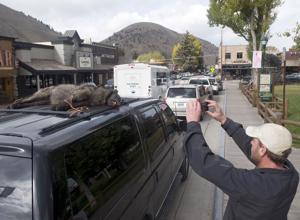New study questions wolf hunting policies
Group of carnivore biologists casts doubt on state managers’ conclusions, goals.
POSTED: WEDNESDAY, DECEMBER 23, 2015 4:30 AM
A new academic paper in the journal Science questions whether ecological theory and sound data are playing a role in determining wolf hunting seasons in the northern Rockies.
The paper, written by an international group of 14 carnivore biologists, argues that current wolf hunting pressure is not sustainable and that the accuracy of population estimates are not reliable. The authors also call for the states of Idaho, Montana and Wyoming to set clearly defined policy goals.
“We feel it’s time for targets to be defined more explicitly,” Montana State University ecology professor Scott Creel, the study’s lead author, said in an interview. “Right now we don’t really know what the numeric goal is. It’s not stated.
“We know there’s a goal to avoid relisting under the Endangered Species Act — all three states want to avoid that,” he said. “But is that it? ... If that is the goal, what is the ecological justification for that? It’s certainly understandable that there’s probably a social argument they’re responding to there, but is that really the goal in regard to wildlife ecology?”
Wolf hunting is allowed in Montana and Idaho, but in Wyoming hunts have been put on hold by a Washington, D.C., judge’s decision.
The Equality State is home to the smallest wolf population of the three states, and here wildlife managers have openly sought to hold numbers a safe distance from but as close as possible to the now-void delisting agreement: 150 animals. Wyoming’s statewide population, which hasn’t been hunted for 15 months, was last estimated at 333 animals.
In Idaho and Montana, where at the beginning of 2015 there were an estimated 1,324 wolves, goals have been more vague. The populations in those two states are several times the recovery goals and are hunted and trapped intensively.
Creel and his co-authors criticize the U.S. Fish and Wildlife Service for considering Idaho’s counting methodology a sound way of assessing the “absolute minimum number of wolves alive.”
“In Idaho, which holds the largest segment of the Northern Rocky Mountain distinct population segment, tabulated counts are adjusted by substituting mean pack size for smaller pack counts that might have been incomplete (74 percent of packs in 2013) and then multiplying the adjusted counts by 1.125 to account for unseen wolves suspected to be living outside of packs,” the Science paper says.
“Consequently,” the paper says, “the Idaho estimate is (approximately) 1.75 times the number of individuals known to be alive, and the biggest increase in the minimum estimated Northern Rocky Mountain distinct population segment occurred in 2006 with the adoption of this method.”
Mike Jimenez, Fish and Wildlife’s Northern Rocky Mountain wolf coordinator, said he appreciated the academic critique.
“Having people challenge management policy — hunting — that’s a healthy thing,” Jimenez said.
“Having said that,” he said, “one of the critiques that I would offer back is that a lot of the article uses data from annual reports, and the data from annual reports is not research-quality data at all.”
Jimenez used Idaho as an example. He said Idaho managers have purposely curtailed surveillance of breeding pairs once it’s known that there are more than 15, the minimum in the delisting agreement.
Creel and his co-authors, Jimenez said, falsely assumed the lower numbers of breeding pairs of wolves in the reports meant a lower number of breeding pairs in the wild.
Jimenez also defended hunting as a central component to management.
“Think of wolves in Canada and Alaska. They’ve never not been hunted,” Jimenez said. “So did that same conclusion work there?











No comments:
Post a Comment